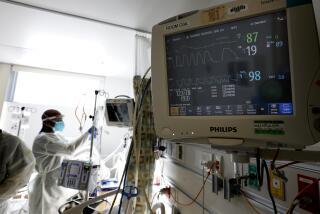Cuba’s Free Health Care System Admired Even by Nation’s Detractors
- Share via
HAVANA — The government describes it as a miracle, visiting experts are impressed and even Cuba’s political enemies do not deny the level, range and efficacy of its free cradle-to-grave medical care.
What Dr. Hector Terry, vice minister of public health, describes as “a Cuban health care miracle” includes medical examinations, hospital and outpatient treatment, the most up-to-date surgical techniques and comprehensive dental care.
Asked how Cuba does it, Terry said the key is political will.
“The United States is infinitely richer than we are but it does not have the political will to provide the kind of free health care that we have,” he said.
Rural Deprivation
There was no political will in pre-revolutionary Cuba, Terry said, when millions in rural areas had little access to systematic medical care.
Since the early years of the revolution, when half of Cuba’s 6,000 physicians fled the island, President Fidel Castro has dreamed of making his socialist nation, in his words, “a medical power.”
“Neither money nor resources were spared, although perhaps it meant a somewhat lower standard of living in other respects,” Terry said.
Soviet aid over the last 30 years has made the public health system financially possible, according to Western observers.
“The millions of dollars of Soviet aid every day in the form of long-term credits, preferential prices and free military hardware allowed Cuba to invest huge resources in public health,” a Western diplomat said.
Difficulties Seen
“If Soviet aid diminishes over the next decade, as it is expected to do, it will be difficult for Cuba to maintain its current rate of investments in public health,” he said.
He noted that Cuba owes Western creditors $6.4 billion, which it is unable to pay.
Cuban hospitals have diagnostic machines that cost $3 million each as well as the latest machines for the nonsurgical treatment of kidney stones.
This year more than 3,600 physicians will qualify, more than all the doctors on the island in 1964.
Medical school is free except for textbooks, which are inexpensive.
36,600 Physicians
The graduating class will bring the number of physicians to more than 36,6OO, or about 30 for every 10,000 Cubans. Four of 10 doctors are women.
Beginning with the class of 1964, all medical school graduates have been required to work for the government-run health care system. Only a few private practitioners remain.
Most doctors work in one of the country’s 882 hospitals or multipurpose clinics.
In recent years many new doctors have been assigned to the “family medicine plan.” An idea of Castro, the plan aims to have all of Cuba covered by a network of neighborhood family doctors by 1995.
The 220 neighborhood family doctors working in Havana attend to the medical needs of about a quarter of the city’s population. They live in the neighborhoods under their care in complexes with an office and apartments for the doctor and a nurse.
Salary Structure
Terry said that beyond political will and Soviet aid, the salary structure has played a major role in the success of the health services. “If we had to pay doctors and administrators exorbitant salaries, we would have never been able to afford our medical system,” he said.
Doctors and dentists receive fixed monthly salaries. A general practitioner who has spent six years in medical school and three years in rural “social service” work is paid $433 a month. Dentists’ salaries are similar.
Dr. Juan Aguilar, a leading orthodontist, said he remained in Cuba because of his conviction that he was contributing to the welfare of his people. “I know that I could be making $100,000 a year or more if I left Cuba, but it gives me great satisfaction to be able to treat so many people who would not be able to afford the services of an orthodontist in another country,” he said.
Salaries Are Good
By Cuban standards salaries of doctors and dentists are good--about twice the average monthly wage.
Terry said that to progress the way it has, the health care system had to cut its dependence on drugs bought from multinational corporations.
“Medicines on the world market are exorbitantly priced. You cannot develop a health care service like ours without having a pharmaceutical industry,” he said. “Besides, because of its economic embargo, the United States has refused to sell us even an aspirin over the past 30 years.”
Today 85% of the medicines used by the public health service are produced within Cuba.
Genetic Techniques
Cuba uses genetic engineering techniques to produce reagents, such as those used for testing AIDS, said Terry, who heads the National Commission on AIDS. Half the population has been tested for the disease.
Cuban hospitals can perform heart, liver, kidney and lung transplants, and neural transplants for the treatment of Parkinson’s disease. They offer prenatal diagnosis for genetic malformations and Down’s Syndrome. There is an aggressive program for detecting breast and cervical cancer.
Terry points with pride to the declining infant mortality rate, an important public health measurement. The rate dropped to below 12 per 1,000 live births last year from 60 or more in 1958.
“Our population is also living 10 years longer than it did back 30 years ago,” he said. “Not bad for a Third World country.”
More to Read
Sign up for Essential California
The most important California stories and recommendations in your inbox every morning.
You may occasionally receive promotional content from the Los Angeles Times.













